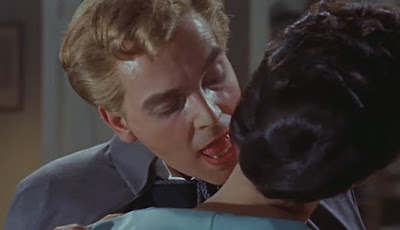Hammer
The Horror of Frankenstein
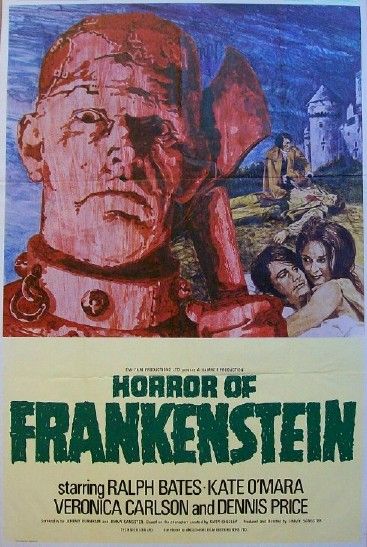
Ahh, just as I was about to go to bed, having finished and (briefly) written up Humanoids From the Deep, I spotted that ITV4 were running Hammer’s The Horror of Frankenstein. In HD.
Well, how on earth could I refuse? Horror of Frankenstein is a fabulously tongue-in-cheek offering from Hammer in their latter days. As something like the sixth in their Frankenstein films, it’s much heavier on the camp action, the smiling buxom women and the smutty jokes than it is on the suspense (Sample line: “I really need to go home and complete my anatomy homework. Will you help me, Maggie?” “Oooh yes, shall I take my clothes off now or later?”) but sometimes a bit of cinematic trash is more than welcome. Hell, did I say sometimes? Cinematic trash is always welcome!
Young Victor Frankenstein is played by Hammer regular Ralph Bates (Taste the Blood of Dracula, Lust for a Vampire etc.), preparing to spend a summer away from school doing all the things that normal college kids do: scientific experiments, pursuing the secret of life, re-animating dead flesh, kid-stuff like that. Bates’ leering aristocratic arrogance is so wonderfully repulsive that he becomes utterly captivating. He’s certainly no Peter Cushing nor Christopher Lee but, to my mind, Bates carved out his own minor Hammer legacy: a sneering, slimy legacy, but a legacy nonetheless.
As a whole, there’s no denying that this is on the lower end of Hammer’s output. Several of the mid-film scenes really do drag and, other than Ralph Bates, little of the actors have much to recommend them (although I don’t think any of the women were cast for their acting abilities…). Despite this, the fun moments are as fun as they mean to be and even the dull moments are lightheartedly dull (everyone knows that earnestly dull is far, far worse!).
The monster, when he finally appears, is satisfyingly monstrous, although anyone familiar with the book (or any half-faithful film) will be disappointed at the monster’s instinctive brutality: we all know the monster is supposed to be a sadly misunderstood mistake of nature. Instead, this film plays out as a kind of cross between Karloff’s Frankenstein - as imagined by someone who’s never seen the film - and Mel Brooks’ Young Frankenstein - albeit without much in the way of jokes.
This might all seem a fairly negative dismissal of what is, essentially a very enjoyable film; I don’t mean it to be. The Horror of Frankenstein is a fairly flawed but entirely watchable blend of diluted horror folklore and camp period drama. It’s hardly memorable but it is great fun.
-————————–
Note: The HD transfer is, though better than the standard definition print, none-too-astonishing. I’m no expert - not by a long stretch - but I’ve certainly seen much crisper HD versions of old films. Whilst I obviously can’t complain too hard (it was, after all, on TV for free) this is someway short of HD worth paying for.
Looking Back: 2010 in VAMPIRES!
First were Zombies, next it’s Vampires! This is the first of my “Looking Back at 2010” posts, in which I plan to have a look at what I watched this year and see what was great (and not so great…). This is based on the list of films I watched in 2010, not necessarily (or at all!) on those released in 2010.
My 2010 count of Vampire flicks clocked in at some 27 different films, although the vast majority were Hammer films. Last year was the first time I really got to grips with Hammer Horror films and I certainly watched a lot of their Vampire outings! I’m a massive fan of Christopher Lee and Peter Cushing, so any of the films with them in leading roles were certainly winners. Dracula (1958), Dracula, Prince of Darkness and Taste The Blood of Dracula were particular favourites from the Dracula cycle, with an honorable mention due to Dracula AD 1972 for being so completely mad. Scars of Dracula was a pretty thin addition to the series and The Satanic Rights of Dracula was nice enough but decidedly underwhelming.
Amongst Hammer’s non-Dracula vampires there are some gems and some… well… not-so-gem-like films. At the crap end of the range were Lust for a Vampire and the Vampire Circus, whilst others such as The Brides of Dracula (yeah… it might say Dracula, but it’s not) and Kiss of the Vampire, both of which were fab. As for Legend of the Seven Golden Vampires, a Hammer-Shaw Brothers collaboration…. I have no idea what to say. It was certainly different but I think the basic premise looked a lot better on paper than it did on screen. This was certainly not a demonstration of how best to mix the gothic and the oriental!
Much more skilled at relocating the Vampire to the Far East was Chan-Wook Park, whose staggeringly wonderful film, Thirst, is surely a must for anyone who likes Vampires. Or Korean films. Or cinema. Chan-Wook Park seems a little cursed by the fact that everyone who’s seen his films seems to just want him to make Oldboy again. And again. And again. Thirst isn’t Oldboy. But it is brilliant. And you should watch it.

Similarly unmissable, although in a VERY different manner was the sublime Vampire Girl Vs. Frankenstein Girl. I hardly need to say very much about this. If the title entices you and/or you’ve seen (and liked) any of the Machine Girl, Tokyo Gore Police etc then this is definitely one for you. If not… well it might be better if you gave it a wide berth. This is definitely one for the bonkers, genre-horror fans.
Back in Western cinema, Let The Right One In and Dusk Till Dawn both entertained me this year, but everyone knows about them so I shan’t really bother banging on about them too much. Instead, I’ll come to the Vampire films that I watched shortly after the stars/directors died this year. Both Lesley Nielsen and Jean Rollins were (very different) losses for cinema this year and to commemorate I watched (amongst other, non-Vampire films) Nielsen’s Dracula, Dead and Loving It which was entertainingly mad and then Jean Rollin’s Requiem For A Vampire and The Nude Vampire, both of which were slow, poetic films with symbolist tendencies.
And that pretty much brings me to the end! There were a couple more, the oddball Blood and Doughnuts, the brooding English Vampyres and - possibly my favourite film, possibly to be reviewed shortly - the Spanish masterpiece Arrebato, but we’ll save them for later…
Hammer Horror - Dracula and Brides of Dracula
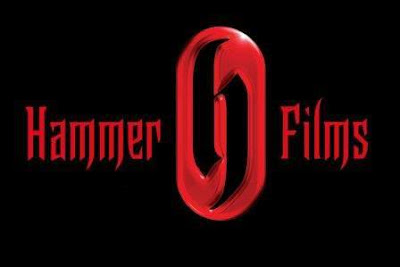
Part of the aim of writing this blog and of taking more notice of what I watch, is to improve my general film knowledge and to encourage me to fill in some of the gaps - whole genres and famous names that I know little or nothing about.
Sometime of course, fishing about in new genres just isn’t appealing and I’ll settle back into the safety of the Spaghetti Western or a predictably nonsense ‘horror’ film - like Attack of the Killer Shrews. Recent viewing however has seen me beginning to get to grips with classic American Film Noir (about which I’m sure I’ll write something soon) and, for this post, the wonderful world of Hammer Horror.
I’m not quite sure how on earth I’d gone for so long with very little awareness of Hammer’s output. As a firm fan of both Christopher Lee and Peter Cushing, with a fondness for slighly camp British horror of the last few decades, how had I never really become a Hammer fan?
Thankfully, I am now very much a Hammer fan. I bought A New Heritage of Horror by David Pirie (I.B.Tauris, £15) which, however much he tries to deny it in his introduction, is basically a history of Hammer’s film output. And none the worse for it. Much as my love of Zombie films was gently lead and guided by Jamie Russell’s Book of the Dead (Fab Press, £11), I found myself flicking through this book with a growing list of scribbled down “must-see” titles.
I started with X: The Unknown (radioactive slime crawls out from the centre of the planet and munches its way through some tasty radioactive things), Hound of the Baskevilles (Good fun adaptation) and The Devil Rides Out - which I enjoyed a lot and might have to re-watch and review)
My now fairly strong feeling that I was onto something rather wonderful was confirmed when I moved onto the Dracula series. So let’s start at the beginning shall we?
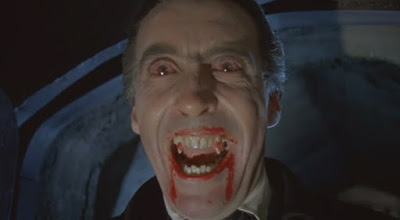
Hammer’s 1958 version of Dracula is brilliant. THere are flaws a plenty but I think it’d be hard not to enjoy the film. It’s well-paced, ever-so British and it has Christopher Lee draining the blood from those around him. What’s not to like?
It was one of Hammer’s first widescreen and colour production and really does look beautiful - although the colour of the blood is decidedly more akin to strawberry than it perhaps should be. Though obviously not being produced on a massive budget, the sets are wonderful, Dracula’s Transylvanian castle is as real as you could hope for and the whole film carries its gothic mood wonderfully.
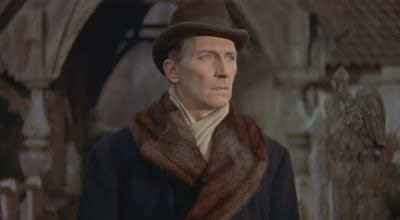
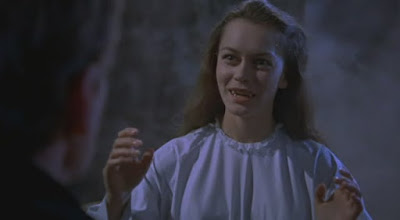
Budget constraints did force them to savage the plot somewhat (Johnathon Harker’s family now live er… right near the castle) and many elelments are missing but this doesn’t particularly hurt the film in itself. Whilst it might suffer in comparison to the novel, the story that remains is strong enough and moves along at a decent pace, aided no doubt by some brilliant acting. Christopher Lee is a perfect Dracula; just the right balance of menace, charm and pointy-teeth, whilst Cushing is brilliant in the somewhat more understated part of Van Helsing.
The film was one of Hammer’s biggest successes and sold well the world over….
….So they made some more.
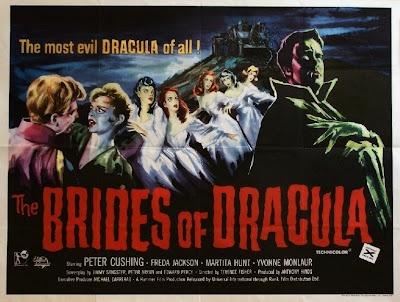
Needless to say, Hammer quickly realised that having Dracula destroyed at the end of the first film wasn’t really the smartest move - they needed more vampire and they needed it now! Similarly awkward was Christopher Lee’s absence; David Pirie writes that it’s unknown whether he flat-out refused or asked for more money than Hammer could spend. Either way, he wasn’t coming back. So neither was Dracula.
Infact, the follow-up to Dracula, 1960’s The Brides of Dracula is pretty surprising as a Dracula film for er…. not having Dracula in it.
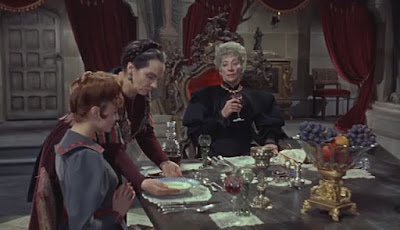
It’s still pretty good fun; Cushing returns as Van Helsing who really does just happen to be in the right place at the right time all over again and is on hand to help stop the rise of the Baron Meinster who has escaped from his perpetual confinement and has gone on a bit of a rampage, sinking his teeth into the necks of the women he meets.
It’s another good fun film, although there’s decidedly less tension to it - despite the fact that I didn’t already know the story, this Baron was so much less charismatic, so much less calm and cool, that I really did struggle to imagine him winning. Needless to say, he doesn’t.
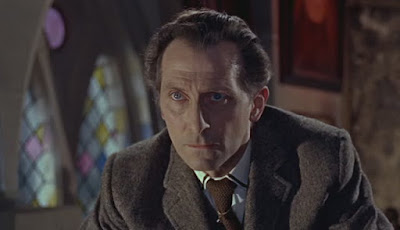
What it loses in tension and atmosphere -especially in the second half - however, it does mostly make up for by being generally a lot of fun. And we like fun films, right?
Of course we do.
